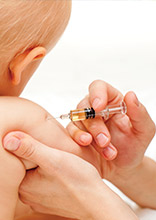Protecting kids when they're most at risk
We all know how important it is to vaccinate a child against harmful diseases but vaccinating a child at the right wrong age can cost lives.
Professor Carol Bower from The Kids Research Institute Australia knows this better than most.
In 1991, she collaborated on a project to assess two infant vaccines against the potentially deadly Haemophilus influenzae type b (Hib) bacterium, which can cause a range of life threatening diseases in young children, including meningitis, epiglottitis, osteomyelitis, cellulitis and pneumonia.
There were two vaccine options on the table at the time - one administered at 18 months of age and several that were administered to infants, beginning at two months of age.
From a cost point of view, it appeared more economical to administer the vaccine after 18 months, however Professor Bower and her research team found it would be grossly inequitable.
At the time 95 per cent of Aboriginal children contracted the Hib infection before they were 18 months compared to 40 per cent of non-Aboriginal children.
"We found that the vaccine at 18 months of age would be totally ineffective for the 95 per cent of Aboriginal children who contracted their disease before that point," Professor Bower said.
"We then conducted a separate analysis of the economics of vaccinating Aboriginal children as infants and found that there would in fact be enormous cost savings and many years of life gained if this group of infants was vaccinated earlier."
"So while administering the vaccine at infancy was more expensive at the outset, the overall long term savings far outweighed that."
Thanks to Professor Bower and her team's research, health department policy makers in WA chose to introduce the infant vaccine for all children in January 1993, six months ahead of its introduction into the national immunisation schedule, and to provide catch-up vaccination for all Aboriginal infants from January 1993.
The new policy saw about an 80 per cent reduction in Hib infection in both Aboriginal and non-Aboriginal children, and a subsequent drop in pneumonia and other complications.
"Further, WA infants had the advantage of six months lead time, which we estimated resulted in 20 fewer infants contracting Hib infection in this period."
Professor Bower said the introduction of an infant vaccine has protected both Aboriginal and non-Aboriginal children from Hib infections and helped to reduce the gap between health outcomes for Aboriginal children.
What's next?
Surveillance of Hib and other infections continues at the Institute, in WA and nationally, to assess whether other infectious agents (or other types of Haemophilus influenza) might take hold in the niche vacated by Hib infections.

